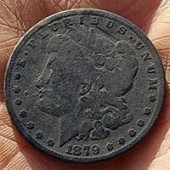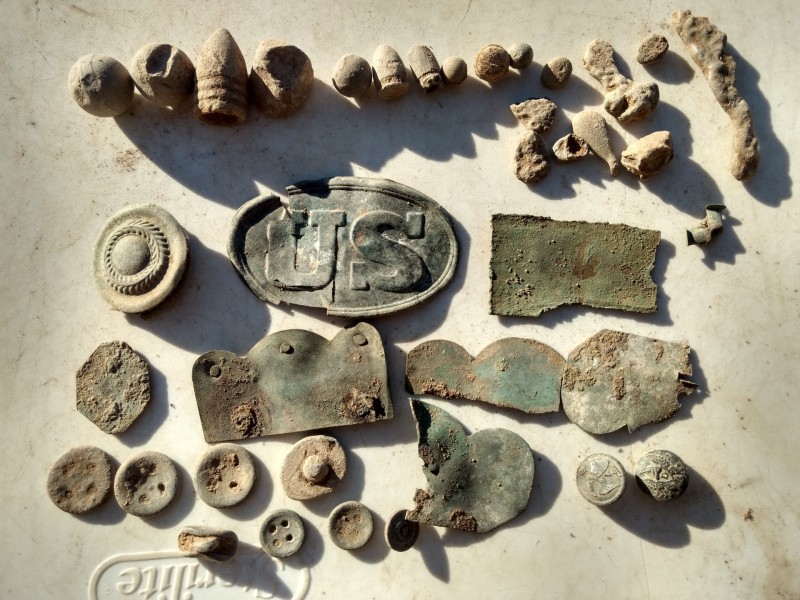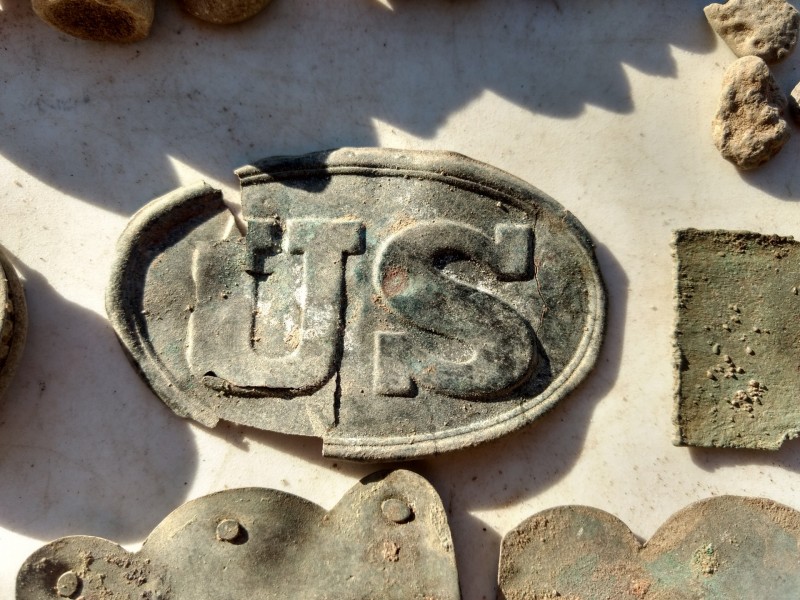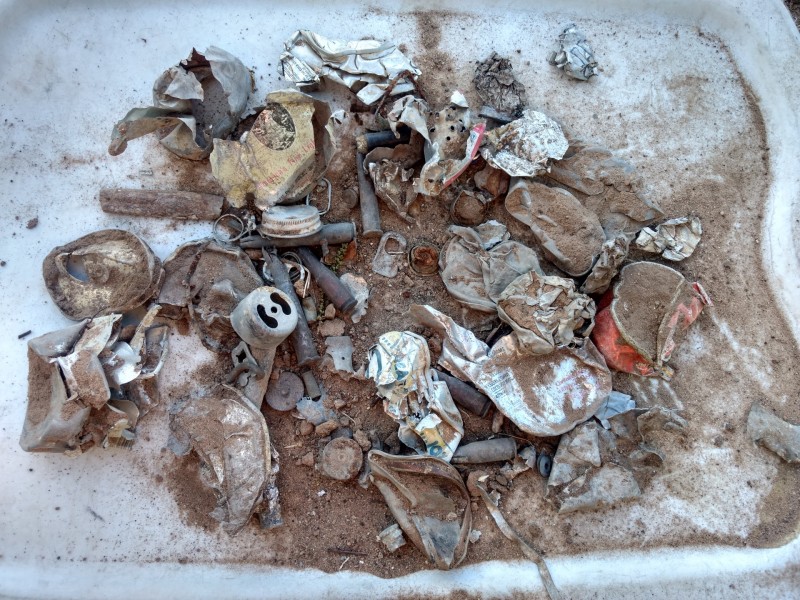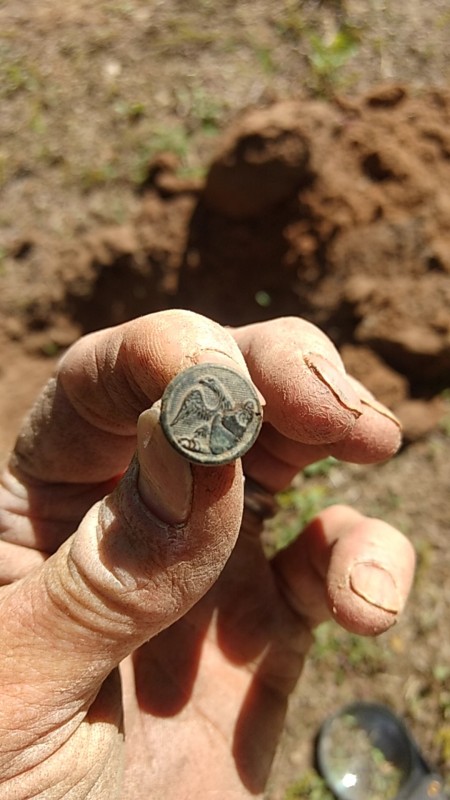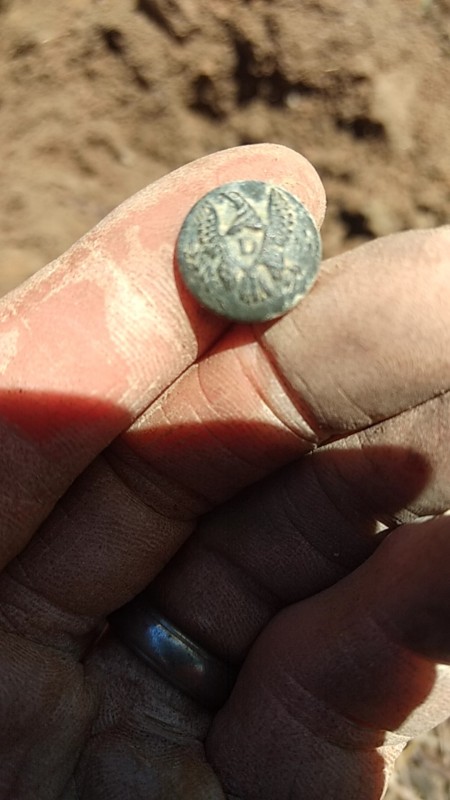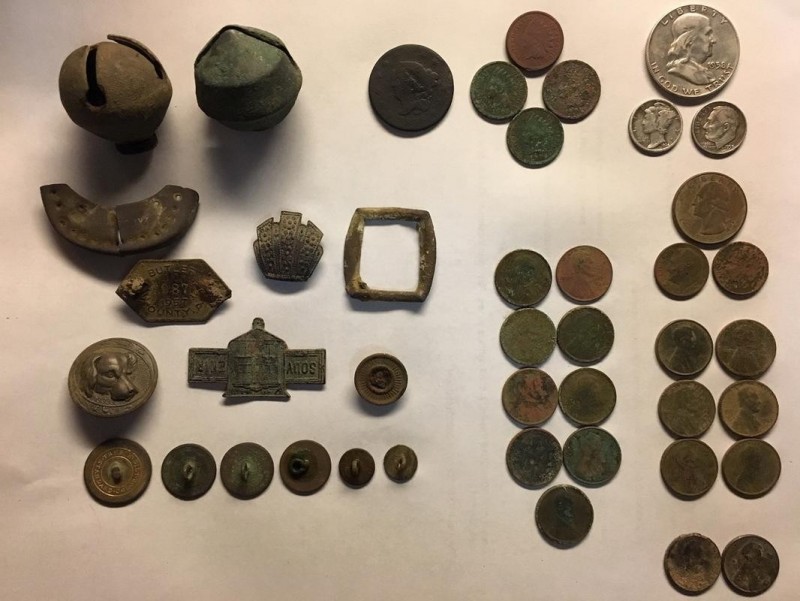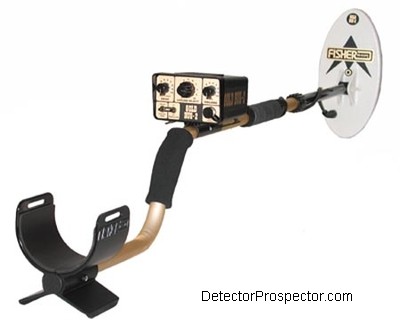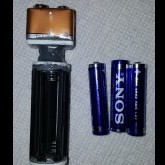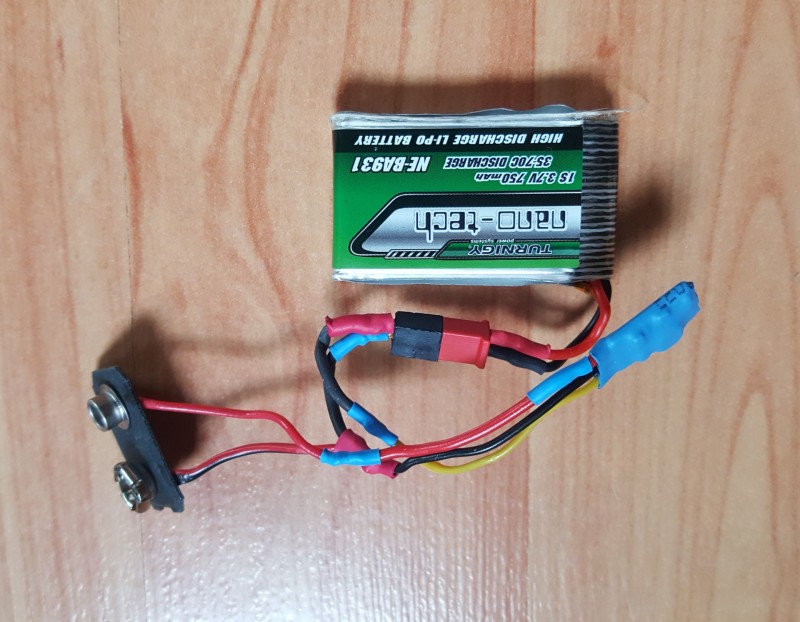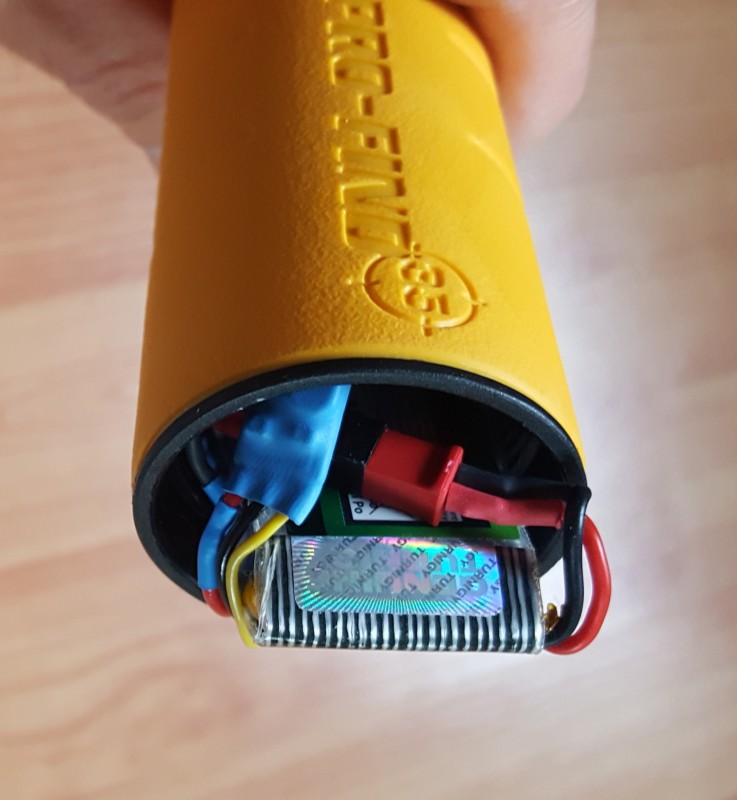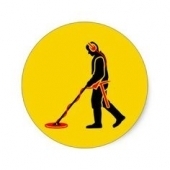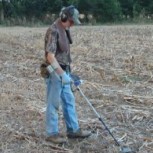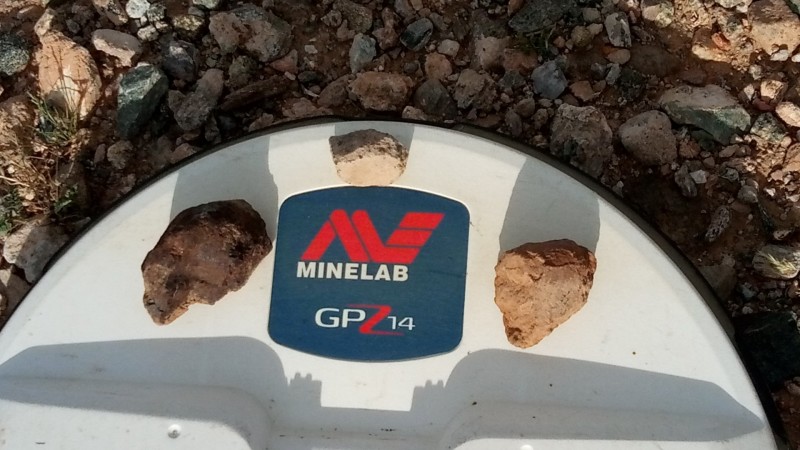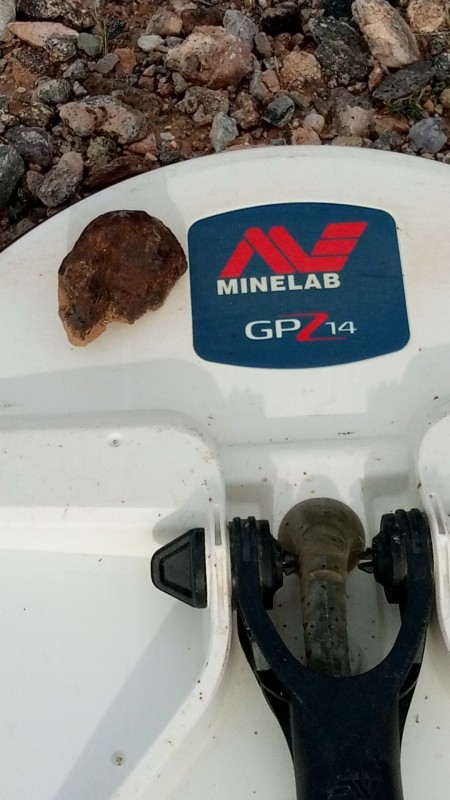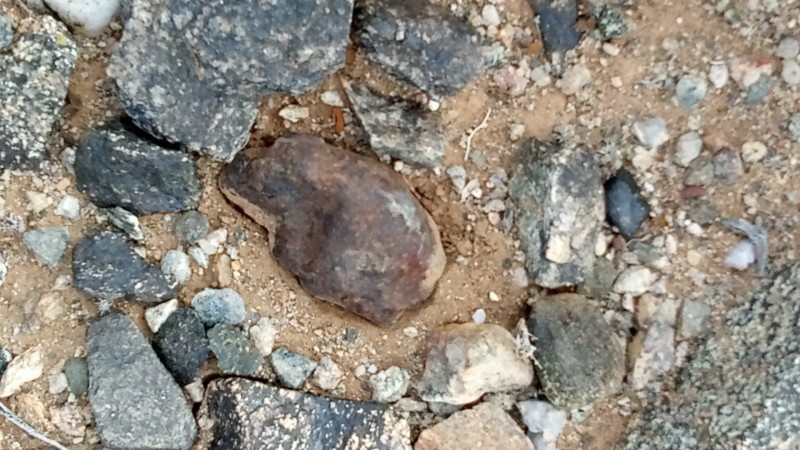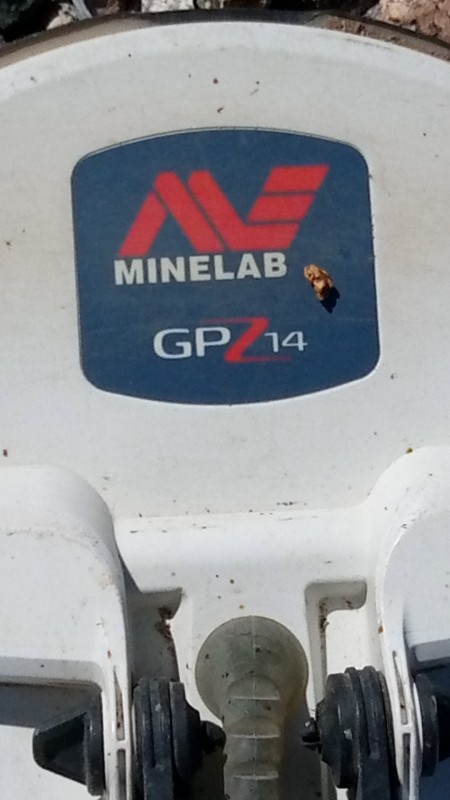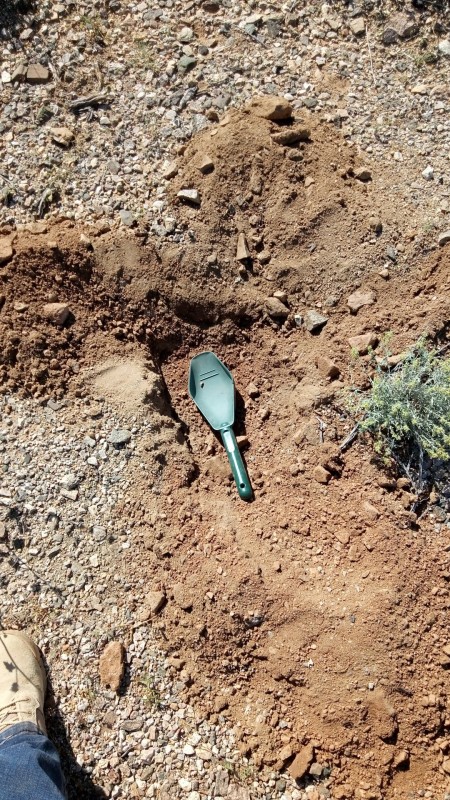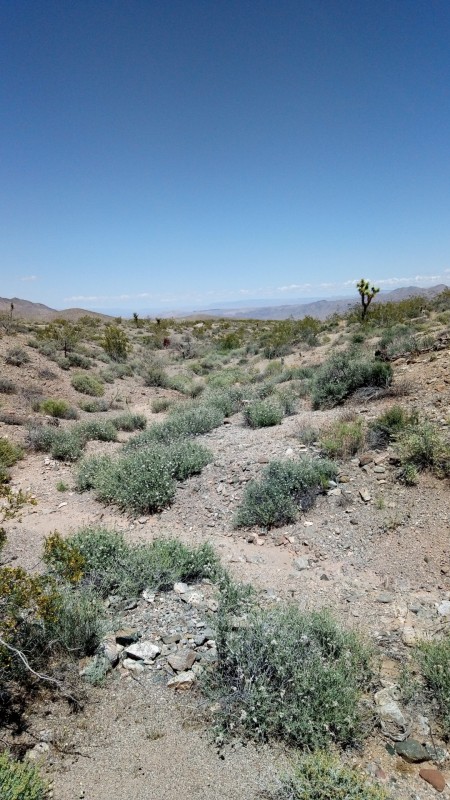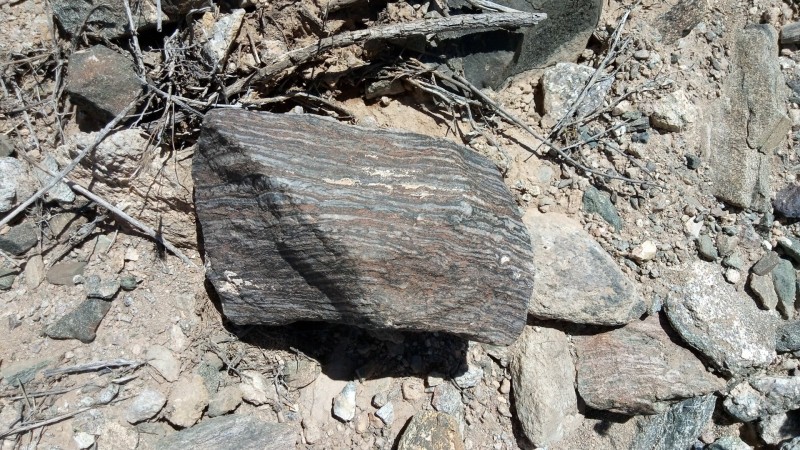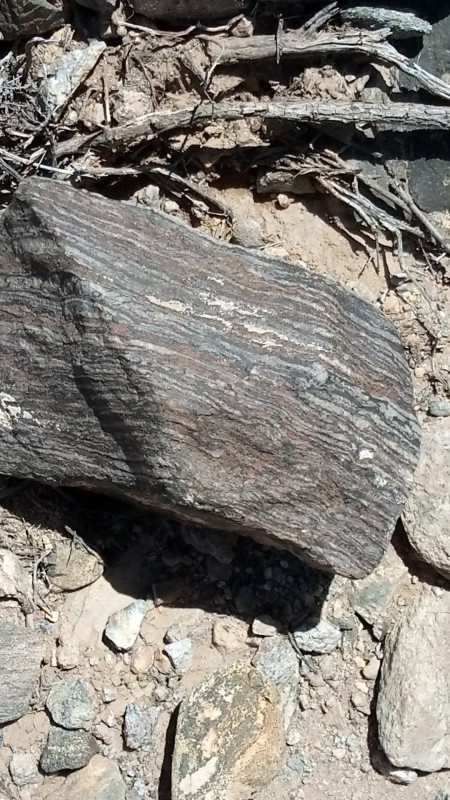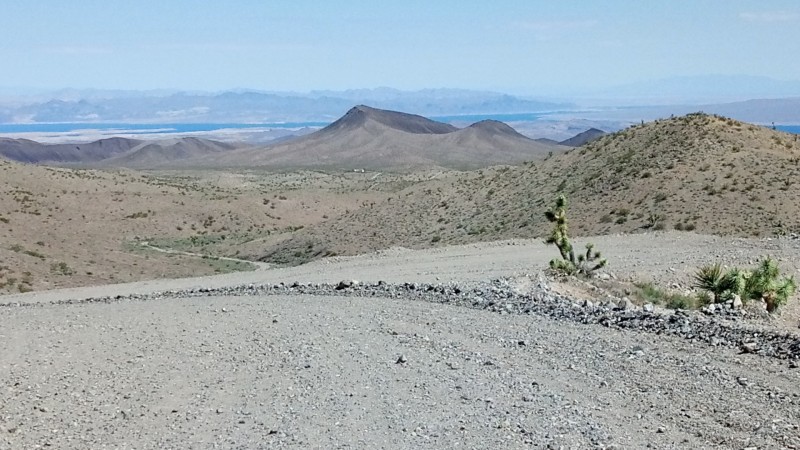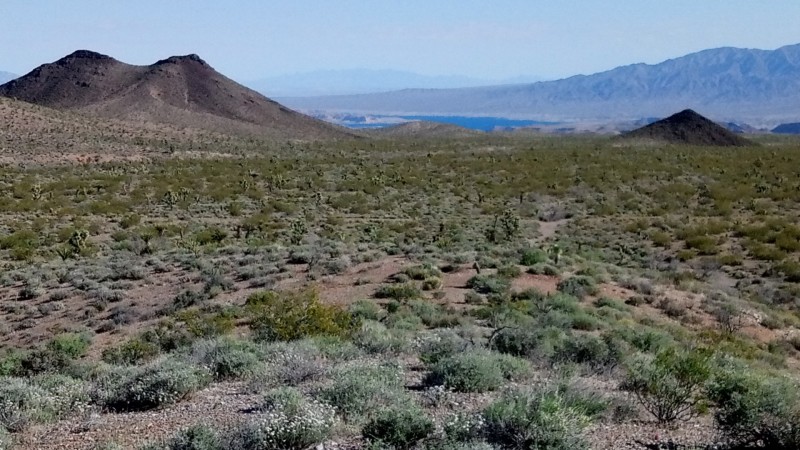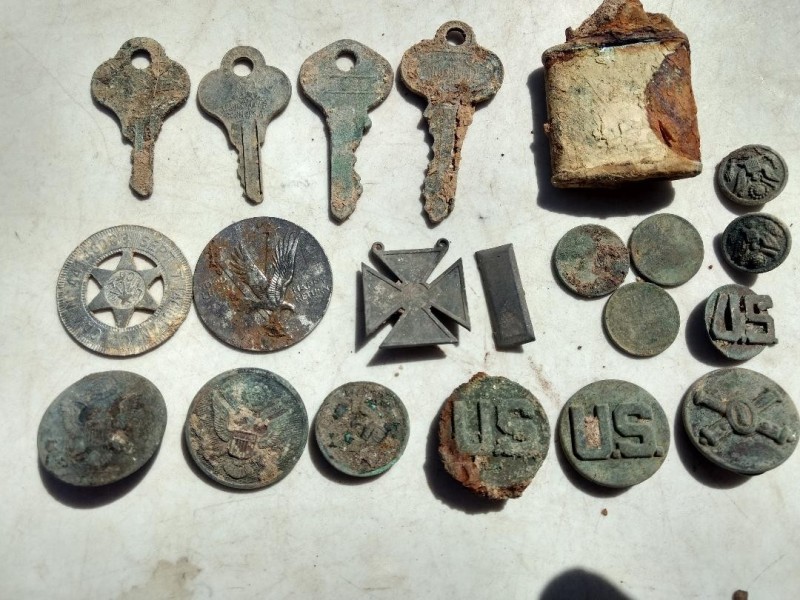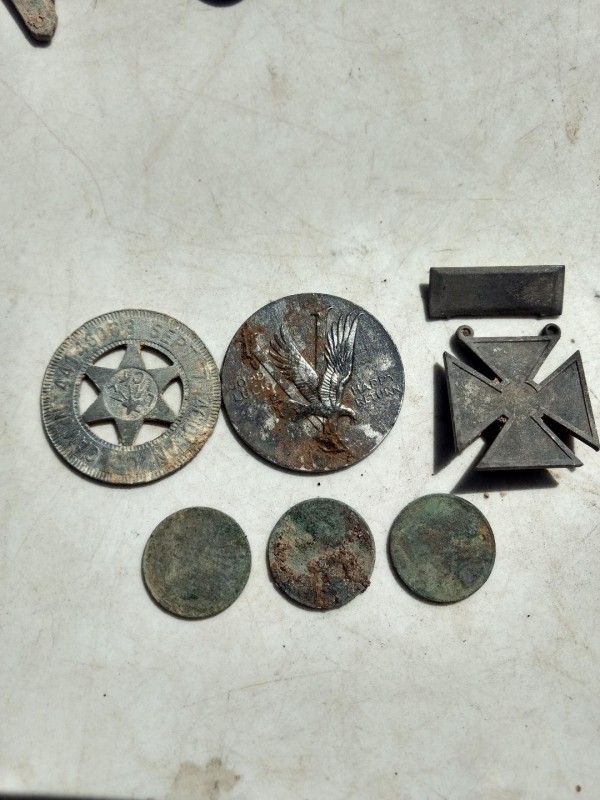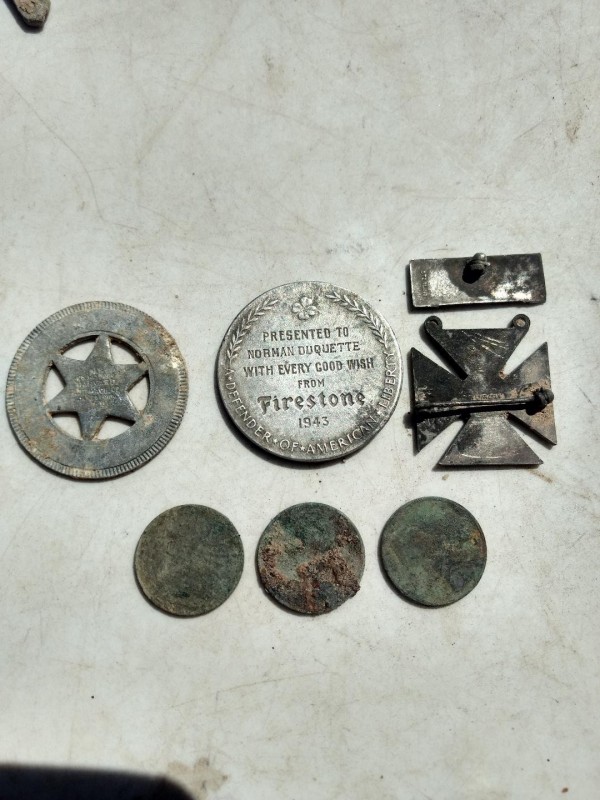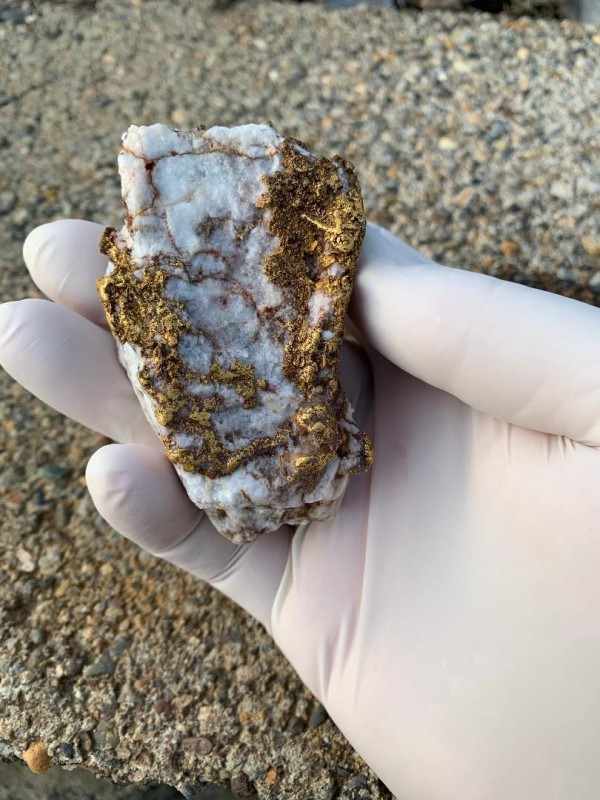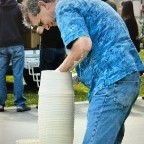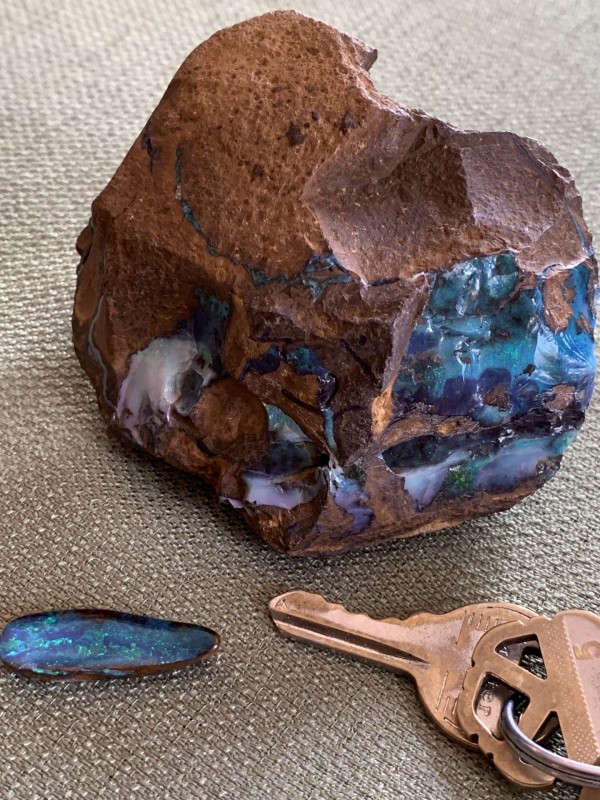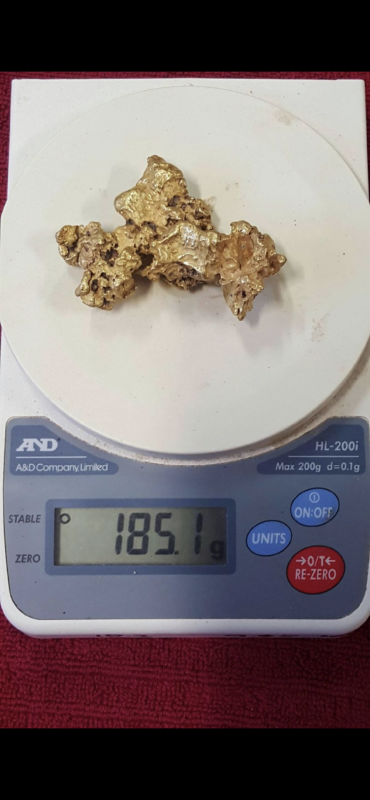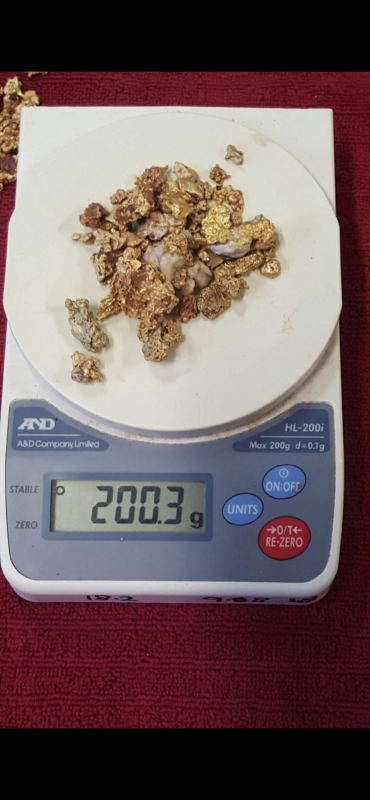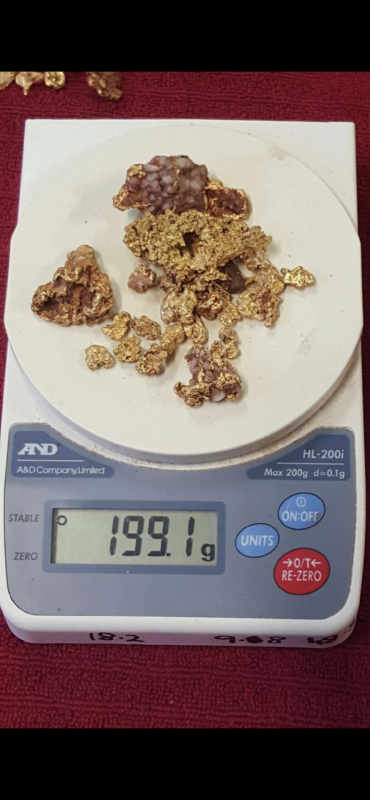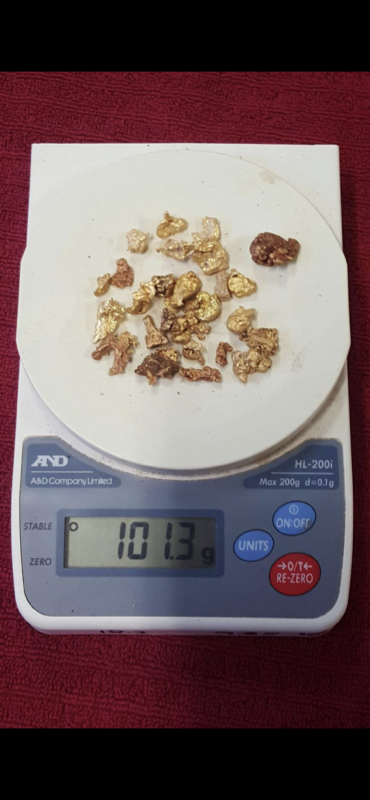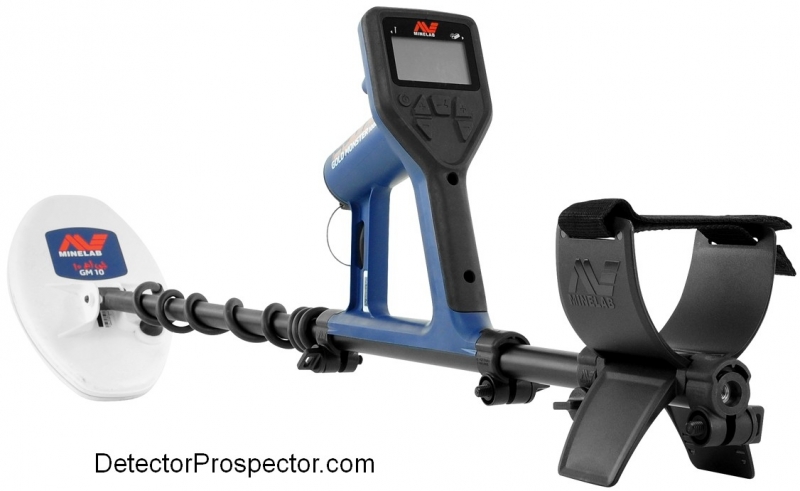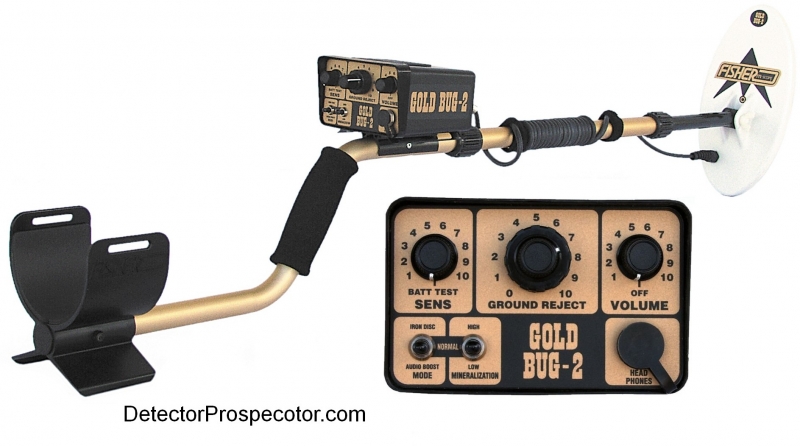Leaderboard
Popular Content
Showing content with the highest reputation on 05/06/2019 in all areas
-
So I titled this as such because when it gets especially hot (here in Arizona) I start my hunts at midnight and go thru until the morning until about 8am. For me, this offers multiple benefits. There is more time with the family on weekends, which for me is #1; I cherish this more than gold. And secondly, if it is hot out, I cannot keep my ground balanced, as some put it. When it starts getting hot, I would tend not to look as hard and rush through areas. Anyways, back to the gold. I was in a wash last week when I ran into some pretty good gold. I found 11 small pcs adding up to almost 4 grams. Now, for my night hunts, I won’t go every weekend, I usually skip 1 or two so that I get my sleep cycle working again. But then there is Mother’s Day coming up and so my wife briefly mentioned that I should go this weekend, too. An hour later I am charging batteries. She walks by and says, “wow, you really have the fever don’t you”. I just laughed. She knows me. She has seen me prospecting for 5 years and put up with it for 5 years. One of the best decisions I made was marrying her. I explain all of this because it was nice to come home and show her the source of the fever. So I went back to this area with my GPZ and started walking through more washes I had marked out on my gps. Nothing for the first one, but the second one, I got a nice strangely shaped 2.75 grammer. Now, I can kinda see a patten on my gps when I look at my finds. I finish the wash and go to a wash that is in the direction of the gold distribution. Good topography … I am in. First couple of minutes of slow hunting in this wash yields, nothing. And then I start focusing on a bench that is maybe a foot higher than the rest of the wash… and I get a signal. A clear, still loud, but smooth signal. My heart jumps as I begin to dig. The dirt just fell away until 15-16” I hit gravel. By now the target was booming. I scrape the gavel back with my pick and I see a large piece of gold flip out! It replays in my mind over and over. Needless to say, you may have heard my scream at 2:15 in the morning (Arizona time). LOL. From there the gold kept coming. I got a couple more pieces farther up the wash and then came back and placered the area for a couple more little ones missed by depth. Wide range of sizes. THAT is why I love the GPZ. And it was nice to see my wifes face change to a smile when she felt the .86oz chunk fall into her hand. Priceless. All in all, my findings came to just over 1oz. Who needs sleep ... Andyy7 points
-
I agree with JW - dig them all. I did find small lead shot was a consistent, rounded noise whereas tiny gold gave a similar noise but with a crackle to it. Almost always knew when it was a less than 0.25 gram piece as it all sounded similar. But I also got gold that sounded exactly like lead shot. And 2 of my bigger pieces I was 100% that I was digging an old square nail. If you are trying to discriminate with a GPZ my feeling is you will be leaving gold behind. JMHO ?5 points
-
4 points
-
10 hours until wheels up for ..... Queensland goldfields...(lol) yeah thats it Queensland or Victoria--not sure which, but i do know thats where the gold is---- laying on the ground in heaps after that last tectonic plate shift !!!! I heard rumors of gold squirting up out of the ground and landing like pillow lava.... be sure and get a good ute or you wont be able to carry the nuggets back... Too bad they also said that tectonic shift causedd a major dip in WA and all the gold there is now 300 met4ers deeper than it was before-- Guess i can get some beach hunting in and then go seemy new fillapina wife if I get bored.... May have to hook up with Norvic and DaveW to get any real gold this year...... See ya all around -----?----Cheers you lucky dogs!4 points
-
Hi all! I just returned from a short vacation back home in western PA, and squeezed in a couple of hunts at a few old sites -- an 1872 farmhouse, an 1885 house, an early to mid 1800s foundation, and a 19th century cellar hole...plus a short time at an old church or school house estimated to be late 1800s. I managed a nice variety of finds; here are some of the better ones. The large cent is 1818, the pinkish-looking Indian is an 1863 fattie. There is writing on most of the flat buttons, but the only ones I can make out are the gold-gilded one that says "TREBLE GILT STANDARD COLOR," and one other that says "SUPERFINE STRONG LONDON." Does anyone know any ages on those? The round crotal bell says "OCT 24 76 & MAY 14 78" -- and has a maker's mark that has a small circle, then a diamond with a plus inside, and then another small circle. The other, acorn-shaped bell has no markings... Steve4 points
-
The only consistent noise a tiny nugget makes,is the rattle in the keep jar.4 points
-
I hate to distract us from the spirited discussion of ZED aftermarket coils and new gold detectors, but I've been working on a plan to spend a few months downunder detecting WA. I sold some gold to finance the operation and convinced my Baja detecting partner we need to get us some Aussie gold. Just so you know I'm not a idiot and going off half cocked here, I purchased the premium edition of Nurse Paul's primer "Yank's guide to plundering Aussie Gold". Some very helpful information..."when handling sharp digging tools, always wear flip flops". Or the timeless, "When drinking a few cold ones with the locals, the acceptable ratio is 3 to 1. Buy 1, drink 3, it makes them feel superior." What could possible go wrong with that kind of wisdom at my disposal? Yeah I know, $16,000 worth of detectors got stolen while he slept on watch, but that could have happened to anyone. He's matured alot since then. Seriously though, we leave May 19 and don't expect to return until my 90 day visa expires. Paul has in fact helped me get a handle on the geography, Ute selection and basic gear requirements. We'll be boondocking it, living on road kill and brown snakes with a case of Vegimite for emergencies. I've already purchased one of the new X-coils 17" for the Zed which will be waiting for me when I arrive. I had a sacrificial coil cable for the jumper connection since I destroyed the original 14" stock coil, long story, but apparently you're not supposed to drag that coil behind the Rokon at cruising speed down desert dirt roads for a couple miles. Who knew they were so fragile? Wore right through the plastic housing and exposed the copper windings, bummer. But, I've got me a $900.00 Minelab chipped coil cable so the glass is half full. Nevertheless, an adventure is at hand. I'll post updates and photos as opportunities present.4 points
-
“A man who unearthed a £145,000 Anglo-Saxon pendant has found more treasure dating back about 800 years. Tom Lucking's latest find saw him dig up a brooch dating back to between 1200 and 1300 in Wymondham, Norfolk in September. In 2014, the then student found a pendant in Winfarthing, Norfolk dating from circa 630AD. Mr Lucking, 27, said the brooch, which features two lions and is studded with two pink stones, was a "special" find.” Full story and photos here3 points
-
Everyone's input matches and clarifies what I have always done with the GPX and the GPZ - dig (mostly), everything. I have found gold with almost every sound the detector makes as well (except for waltzing Matilda) but decided to ask my kind-of-stupid question to get clarification from the forum inhabitants. Thank you all.3 points
-
Now you'll have started something. JW and Phrunt will be along any minute...?3 points
-
Northeast, the lambs were very time demanding, so I ended up giving them to a lady who who was a wool classer and who had sheep of her own. She said they were very well bred and would be wool producers. I did get quite attached to Jackie, as she had real personality.3 points
-
How did you get hold of that phrunt???? Do you want to spoil my image?3 points
-
3 points
-
2 points
-
The way a signal sounds can have a lot to do with were the GB position ends up relative to the ground your working and the Gold mode and Ground Mode you are working in. A signal response in High Yield Difficult can sound a lot different in High Yield normal or any of the General modes. Generally smaller targets go High/Low in High Yield and bigger more solid bits go Low/High. Shallow Steel objects will often go Low/High but will be a tight signal response due to distance from the coil. This all changes around somewhat if the timings are changed. Quiet often you can also receive a confused signal or as a friend of mine likes to describe them, a turkey gobble signal (maybe even Waltzing Matilda ? ), this is where both channels respond equally and try to cancel each other out a little like noise cancelling does. JP2 points
-
At this point in time I think we are decades in to understanding the "dig it all" mantra, and in my opinion there isnt much left to discuss since it's a simple concept that everyone already agrees on. So it kind of surprises me to see how many serious detectorists are content at leaving it there. The more interesting thing to me is when not to dig it all. If anyone thinks there is never a time to pass over targets then I guarantee you are missing more gold by being stuck in old ways than by realizing you can produce more by knowing there is a time to pass some targets up. Consider some basic math, a philosophy which i used dredging and carried over to detecting. Let's say we accept 20% losses because I alter the sluice so it doesnt clog so much and I can run material faster over it (by removing the hungarians as an example) in return for doubling the material I run. In dredging that means I get 8 grams for running the same material instead of 10 grams. But I've doubled my material I run so I actually get 16 grams instead of 10 grams at the end of the day. Same with detecting. Covering more ground is like running more material dredging. I accept say 20% loss of nuggets I miss in return for operating in a way that let's me cover 2x more land. That's actually an underestimate, I probably cover 3 to 10x as much land as a lot of the dig it all people I see detecting cover in a day. An average day detecting on my GPS is 2 to 7 miles walking, usually 4 miles a day is pretty normal. If I am comfortable getting 80% of the gold in half or less if the time and then moving on and finding a new area, not only do I find more gold than if I stayed and dug every target in the end, but I end up with far more known producing areas discovered at the end of the season. And I go back to these areas at the end of the day if I've been skunked exploring and then THAT'S the time to grid and dig em all, and I end up with a lot of these areas in my back pocket to rely on whereas someone who stayed and just dug everything now has nothing left and no new discoveries either, starting from scratch every time. My way always keeps you in the gold and producing. Not just good for the pocketbook, but for the mental condition as well where going on skunk runs can be demotivating. All that aside, having done this for years, I've discovered that even when I'm being highly selective I'm still only missing about 10% of the overall gold I end up finding when I do finally go back and clean up every single trash target. Yet I easily produce 2, 3 maybe even as much as 10x more gold per trip than I would if I simply stayed and dug everything until it was gone. This is how you make detecting pay for itself if you aren't retired or depend at least some on the income you make finding gold. What isnt communicated properly when green horns read forums and threads like these is that a lot of the dig everything guys in the US who make fabulous finds are in fact just in tiny areas of private land or leased land which no one has access to, or claims which have been in the family for decades or longer, with heavy equipment at work. These people can afford to dig everything because they dont need to explore as much as the newer guys do. And a lot of other guys are shown places to go and dont have to put the work in to find them or go on 3 week long skunks and question why they ever bought a detector to begin with after digging 600 pieces of tin. Having recently spent a large amount of time cleaning out old "80%" areas I left behind for later, I've discovered that actually I got closer to 90 or 95% by selectively digging, and that's well within what I consider acceptable. A lot of age old mantras are repeated for a reason, because they are correct. But the trick is understanding when they aren't. For instance, there are perfectly good times you dont want to keep your coil perfectly flat even though coil control on the forums would make you think there is a school marm waiting at every patch to rap your knuckles if you dont. Any different response you can get from a detector is potentially useful information. Data needs to be correlated and interpreted to your specific conditions, and tested and compared to see if it's a bad habit or potentially useful information. This is why I cant get behind this school of thought that seems to be getting common around forums that testing, measuring and comparing is not worth the time. This stuff has all been the key to my success as a person that started without anyone to help or show me where to go. And I know most random people starting out are finding themselves in the exact same boat as I was in, so if you are one of those new guys I'm letting you know that there are other ways to do this stuff, some of which are probably better for the conditions we find ourselves in today, and especially if you dont have a friend or buddy to put you on already productive ground.2 points
-
It's a Massachusetts state seal button. Not sure if these are classified as Mass Volunteer buttons. There are quite a few varieties. Not sure on the dates, but I think some are pre Civil War as well as Civil War. Hopefully someone can help you out better. Possibly could be MS31 in Albert's button book (Record of American Uniform and Historical Buttons)2 points
-
My ORX has the round 9" HF Coil. The included headphones are HORRIBLE after about 45 minutes. They cut into my ears something fierce when being used. There is an adapter you can get but have yet to buy it. Although if I'm going to keep running the ORX that would be a necessity. It's a really light machine, swings ultra easy. Wish it had some notching capabilities though on the disc side. I see where you are coming from here on this response. I do enjoy metal detecting a lot and have off and on for many years. It's true what you say, it takes time and practice to learn a machine. The point here on my end is that I'm trying to assemble a "work crew" with the detectors. No one detector can do everything, regardless of sales hype and marketing. This is understood. One particular brand/model might be tops with one aspect (trash) where another is better for depth (cleaner sites). It's tough to pick a detector today and with all the videos, marketing hype, etc. it can be very confusing for people just getting into the hobby, even people who have done it for years. By the way, I've not ruled out the Teknetics T2 Special Limited Edition with the two coils. Looking at it pretty hard actually. Price is right on that one at $599. It seems to be a very capable versatile machine and I'm sure it would take a while to learn it and tinker with it. The thing can pretty much do it all, and is a proven unit to hear most sites and people talk. It is old technology, it is single frequency. And that in itself seems to be a taboo thing these days. If I was going to entertain an Equinox again, would get an Equinox 800. But that would still put me in hock and needing the little coil again. In a way I DO regret getting rid of my Equinox 600, but like many others I did "wonder what I was missing" by NOT getting the 800. The Equinox was a decent machine for me but the tone pitches really wreaked havoc on my ears and for some reason I had a lot of difficulty with it. The ID was very tight also, not giving you much room and mine did struggle at an iron infested site.2 points
-
After reading that article Reg you can consider your image spoiled, you big softie ? Unless you say “They ended up tasting quite nice” ?2 points
-
I said that from memory but thought I'd better check the numbers. Redbook says "not quite." Here are the order and mintages (for Roosies): 1955 (plain) -- 12.8 million 1949-S -- 13.5 million 1955-D -- 14.0 million 1955-S -- 18.5 million 1954-S -- 22.0 million 1949-D -- 26.0 million 1946-S -- 27.9 million So the 1949-S snuck in there at 2nd place. Note the 1955 (plain) is the only one of the top seven from the Philadelphia mint. That is typical for first half of 20th century US coinage -- more coins minted in Philly than either branch mint. (Starting in the 1950's the Denver mint replaced Philly as the most proficient.) Even during the 19th century the Philadelphia and New Orleans mints were typically far more productive than San Francisco and Carson City (not to mention gold coins from Charlotte and Dahlonega). This is why the Western detectorists have an edge, IMO, in finding valuable coins. The East coast has the oldest coins but typically not the rarest.2 points
-
This is my latest "Nugget Detector Guide", now published for over twenty years, updated January 2024 with some of the latest model information. Each model has a short description, followed by a very PERSONAL OPINION. Copyright 2002-2024 Herschbach Enterprises - Please do not reuse or repost without my express permission. This is offered as a simple guide for those wanting a comparison of the various nugget detectors available new with warranty, along with some kind of real opinion about them. That's all it is, folks, so take it or leave it for what it is worth. It's just that listing specs is of little help to people, and so I take my best stab at providing some guidance for those newer to detecting. These are only my opinions based on my experience with various detectors over the years. While I do have a lot of experience, I must throw in the caveat that I have not used all detectors under all conditions. What may be considered a good detector at one location may not be so good at another location due to differences in ground mineralization and the gold itself. Detector performance is site specific and so your mileage may vary. Never forget that when reading comparisons on the internet. Although many detectors sold today can potentially find gold nuggets, I've chosen to only list current models from major manufacturers that are sold and marketed primarily as prospecting detectors or that at least have a specific prospecting mode. I no longer list general purpose VLF detectors running under 18 kHz because they are too common and that being the case they offer nothing special to the potential gold prospector. If you are interested in other general purpose detectors that might make good prospecting machine but are not listed here, look at my more comprehensive reviews list. Many discontinued prospecting detectors are also listed there. Various popular VLF gold nugget prospecting metal detectors Please, if you own one of these detectors, and I call it like I see it, don't take offense. Any nugget detector made will find gold in capable hands, and the owner is far more important than the detector model. I'll put a good operator with almost any detector on this list up against a novice with whatever is deemed "best" and bet on the experienced operator every time. The person using the detector finds the gold. The detector is actually one of the less important factors in nugget detecting success or failure. A quick note to those who know nothing about these machines. These are metal detectors. There is no such thing as a "gold only" detector. These detectors will also find lead, copper, aluminum, and other metals. These units are best used to look for relatively larger pieces of gold at relatively shallow depths. Concentrations of gold dust are not detectable. Some of these units can hit gold that weighs as little as a grain (480 grains per ounce) or less but only at an inch or two. Only the larger nuggets can be found at depths exceeding a foot. Only world class nuggets weighing many ounces can be detected at over two feet. The vast majority of nuggets found are found at inches, not feet. About Long Range Locators (LRLs) WARNING ON COUNTERFEIT DETECTORS - The market for nugget detectors far outsells coin and relic detectors worldwide, with huge sales in third world countries. This has made many of the models below very popular with counterfeiters. Here are some Fisher and Minelab examples. If you shop these models there are two simple rules. First, you are safe if you stick with approved dealers. Second, if the price seems too good to be true, beware! All legitimate dealers have a limit on how low they can advertise, the Minimum Advertised Price (MAP). Review prices at the approved dealer list, and if you find the detector advertised as new at a significantly lower price by somebody not on the list, the odds are very high you are looking at a counterfeit detector. Legitimate dealers are prohibited from advertising at those kind of prices, and a price too good to be true is your number one warning you are about to be ripped off. The detectors are listed in order based on the lowest price normally advertised on the internet as of the date below. Steve's Guide to Gold Nugget Detectors - Updated January 2024 Before I start, a quick note about recent events in the metal detector industry. A few years ago we lost a major manufacturer in the form of Tesoro. That lead to the Tesoro Lobo SuperTRAQ being dropped from this list. 2020 saw one of the true industry stalwarts fall by the wayside. White's Electronics was acquired by Garrett in October of that year. I am therefore dropping the White's nugget detectors from this list as no longer available new with warranty. For now, see my detailed reviews for information on White's models. Bounty Hunter Time Ranger Pro / Fisher F19 ($399, 19 kHz) - This detector is a later, more advanced version of the Fisher Gold Bug Pro (see below), with added features. There is an excellent threshold based all metal mode plus a dual tone discrimination mode. The F19 has both ground grab and manual ground balance, plus adjustable tone break, just like the Gold Bug Pro. Extra features are added to enhance the coin, relic, and jewelry capability, such as notch discrimination with adjustable notch width, volume control, separate ferrous tone volume, and a LCD meter backlight. These extra features may even find use while gold prospecting. The Fisher F19, and the Bounty Hunter Time Ranger Pro, can use any Gold Bug compatible coils plus those made for the Teknetics G2 series, providing for a huge number of possible accessory coils. This detector can be had with several stock coil options, including a 7" x 11" DD coil, or 5" x 10" DD coil. Weight including a single 9V battery is 2.6 lbs. Steve's Opinion - If you can afford it, look at other options below. If you want the lowest price detector worth even looking at for nugget detecting, you can look no farther than here at $399 (or less). First Texas, the manufacturer of Bounty Hunter, Fisher, and Teknetics metal detectors, sells quite a few identical or near identical metal detectors under different brand names and model names. Due to oddities in their marketing scheme, some more powerful models are often available at lower prices than other less capable models. Currently the 19 kHz Gold Bug name carries a premium price, while other identical or more capable models, sold under other names, can often be had for less money. That is currently the case with the 19 kHz Fisher F19 models, and the identical Bounty Hunter Time Ranger Pro model. The bottom line is this. If you can find a BHTRP/Fisher F19 with 5" x 10" elliptical coil for under $500 at a legitimate dealer (see counterfeit note above) it is easily my current recommendation for an extremely capable, entry level, VLF nugget detector with general purpose capabilities. I recommend this detector over the Fisher Gold Bug and Gold Bug Pro models below, not only because of the extra capability, but because it can be had stock with the 5" x 10" DD coil, the best general nugget hunting coil for the FT 19 kHz series. It can only be had as an accessory coil on the Gold Bug models, driving their out of pocket cost even higher. Nokta Gold Kruzer ($549, 61 kHz) - Nokta/Makro started shipping the new Gold Kruzer model in June 2018 and with a change in the company name is now simply the Nokta Gold Kruzer. The Gold Kruzer is a variant of the old Makro Gold Racer that has been boosted to 61 kHz from 56 kHz and put in a waterproof housing good to 5 meters (16.4 ft). The Gold Kruzer comes with a 10" x 5" concentric coil and a 4" x 7.5" DD coil. The weight including LiPo batteries is 3.0 lbs. There are four coils available for the Gold Kruzer. Steve's Opinion - The Makro Gold Racer was one of my favorite detectors because until recently there was nothing running in this frequency class that had full target id and other options normally seen only in coin detectors. The Gold Kruzer takes it all to the next step by being waterproof in excess of ten feet. There are no other detectors running at a frequency this high that are fully submersible with built in wireless capability and therefore this detector may find favor with freshwater jewelry hunters as well as prospectors. The Gold Kruzer is worth keeping an eye on, and is a better value than it appears at first glance due to the dual coil packaging. 2024 Note: The Gold Kruzer has been reduced in price from over $600 to only $549 which seriously upsets the cart. This is an incredible value for what you get and well worth consideration. Fisher Gold Bug Pro ($599, 19 kHz) - Essentially the same as the Gold Bug above with the addition of manual ground balance. The target ID makes the Gold Bug Pro good for more than just nugget hunting, and it will find favor with jewelry and relic hunters. The manual ground balance gives expert operators the control they desire to get the best depth possible. This unit normally comes with a 5" round DD coil to enhance the sensitivity to small gold but other standard coil packages are available. Weight including a single 9V battery is 2.5 lbs. Many accessory coils are available for the Gold Bug Pro. Steve's Opinion - The Pro is the final version in this series which saw several early variations including the Gold Bug above. It is a excellent choice for prospecting, relic, or jewelry detecting and does fine as a coin detector also. However, you are now paying a premium for the Gold Bug name, and the more capable Fisher F19 at the top of this list can be had in a better configuration at a much lower price. The Nokta. Unless you just want the name, pass. XP ORX ($599, 14, 28, 56, 80 kHz) - The XP ORX emphasizes gold prospecting and coin detecting in the promotional material. The XP ORX appears to be a version of the "Africa only" Depar DPR 600 made for sales in Europe, the U.S., and elsewhere. The ORX has been refined from that early effort by the addition of the ability to use the new X35 coils. Steve's Opinion - The XP ORX went through some teething pains with coils before settling into its final role as XPs gold nugget detector. I think the ORX is a great little nugget hunter personally (I love the compact design), but it seems to be overlooked my most serious prospectors, and getting more attention as a low cost alternative to the XP Deus for coin and relic detecting. The new lower price makes the ORX a serious contender, a big step up in capability from the Fisher 19 kHz models above, and a little less money than the Garrett 24K below for a more full featured detector. Garrett AT Gold ($639, 18 kHz) - The AT Gold was a totally new concept in metal detecting from Garrett Electronics when it was introduced. This full featured detector has everything you would expect from a dry land detector - LCD display, full control set and functions, speaker, interchangeable coils, and lightweight. But it is submersible to 10 feet! Even the speaker is waterproof. Note that the unit itself may be submerged but if you want to put your head underwater you will need optional submersible headphones. Weight including a four AA batteries is 3 lbs. The stock coil is a 5" x 8" DD elliptical. Many accessory coils are available for the AT Gold. Steve's Opinion - The Garrett AT Gold was an innovative concept when it was introduced, and was the only waterproof nugget detector option at the time. The nugget hunting world has moved past the AT Gold now, and unless it comes down in price it's hard to recommend for somebody interested primarily in a nugget detecting VLF. Only for Garrett fans really, and even then more for the relic hunting crowd. For a much better option, see the Garrett Goldmaster 24K below or one of several less expensive models above, like the Nokta Gold Kruzer. ads by Amazon... Minelab SDC 2300 ($3599, Pulse) - This model is unique as Minelabs first waterproof pulse induction metal detector. A key feature is that the detector is physically packaged in the proven F3 Compact military housing that is waterproof to ten feet and folds down into an incredibly compact package only 15.7" long and weighing 5.7 pounds including four C cell batteries. Steve's Opinion - I have used the Minelab SDC 2300 and I must say I was impressed. The waterproof compact design is perfect for hardcore backpack style prospecting. The main thing however is that the SDC 2300 comes as close to VLF type performance on small gold as you can get while being almost impervious to the ground mineralization, and hot rock issues, that plague said VLF detectors. In fact, the SDC 2300 will find gold nuggets smaller than most good VLF detectors can detect in mineralized ground. The SDC 2300 is also one of the simplest detectors to use and master on the market. The main caveat is that the detector is optimized for small gold with the hardwired coil, and so other ground balancing PI detectors are a better option for large nuggets at depth. It is also nearly twice the price of the Garrett ATX above, and so you are paying quite a premium for a little better performance on small gold. Still, the SDC 2300 is almost impossible to beat for the price, if the goal is just to go find some gold, any gold at all. If the budget allows, however, at this point I would pass, and go to the new Garrett Axiom below, which offers a much more sensible design, with many more coil options, and better capability for larger gold at depth. Garrett Axiom ($3995, Pulse) - A new pulse induction gold nugget detector, just announced for 2022, available by the end of the year. The Garrett Axion is the first pulse induction nugget detector to truly reflect 21st design options and capabilities. The Axiom is a sleek, modern design, perfectly balanced at only 4.2 lbs with the 11" x 7" mono coil. The detector is fully weatherproof, with waterproof coils. The Garrett Axiom is available in a couple package options, but the most popular will include the 11" mono coil, 13" DD coil, and Garrett Z-Lynk high speed wireless headphones. The Axiom has a perfect balance of controls, giving experts more options than more simplistic designs, while still focusing on only the controls really needed, to keep things easy for beginners. Steve's Opinion - Well, I have to admit I'm biased on this one. I lobbied Garrett every way possible for almost a decade, to make a detector like the Garrett Axiom. So it is literally a dream come true for me, a powerful pulse induction detector in a really great, ergonomic package, and at a price that won't break the bank, but honestly still more expensive than I was hoping for. I have used the Axiom already enough to know that it is very competitive although it is not that it is the most powerful option available. For that I refer you to the Minelab GPZ 7000 below. The Axiom goes head to head with the GPX 6000 and basically offers 90% of the performance of that machine for two thirds the price. Minelab GPX 5000 ($3999, Pulse) - This Pulse Induction (PI) unit essentially ignores ground mineralization and most hot rocks. The GPX 5000 is designed specifically for nugget detecting and so it has many adjustments for mineralized ground not available on other PI detectors. The GPX 5000 is the culmination of over 10 years of innovation in pulse induction technology. The GPX weighs 5.3 lbs. not including the harness mounted battery, which weighs another 1.7 lbs. The detector comes with both an 11" round mono coil and 11" round DD coil. Over 100 accessory coils are available for the GPX 5000 (Minelab, Coiltek, Nugget Finder)! And more coils are being released every year. Steve's Opinion - The Minelab GPX 5000 can at this point be considered the reliable, well proven option, for just about any pulse induction task a person wants to consider. It has found a wide audience not just with nugget hunters, but with beach and relic hunters. This is in large part due to the incredible coil selection. For general nugget hunting however, the GPX 5000 faces new competition in the form of the Garrett Axiom above, for almost the same price. The Axiom is a better package from a physical perspective and more capable than the GPX 5000 on bread and butter small gold nuggets. However for 1/2 ounce and larger nuggets the GPX 5000 still has the edge due to it's superior large coil selection. personally I lean Axiom for the ergonomics but a case can be made for either machine depending on the user. Minelab GPX 6000 ($6499, Pulse) - The Minelab GPX 6000 is a new pulse induction model that is just now getting into end user hands. The GPX 6000 is exceptionally light and well balanced compared to previous Minelab models, and promises to set new standards for ease of operation. The GPX 6000 weighs 4.6 lbs. and has three coils available at launch, an 11" round mono, 14" round DD, and 17" elliptical mono. The detector has built in Bluetooth wireless headphone capability and quick release Li-Ion batteries. Steve's Opinion - Minelab beat Garrett to the punch in making a very ergonomic metal detector for the 21st century. The GPX 6000 is an excellent choice for gold prospectors, with out of box sensitivity on smaller gold that exceeds the Minelab GPZ 7000. Sadly, what should have been rave reviews by users, has been muted by persistent issues regarding bad coils and hardware based electrical interference. I admit I feel like I have a little egg on my face, as I raved about the GPX 6000 a lot when it came out since mine had none of the problems that far too many people have been experiencing. Regardless of that, I still think when it is running like it should, the GPX 6000 is a superb detector. The closest competitor is the Garrett Axiom for $2500 less. I do think the GPX 6000 retains a small performance edge over the Axiom but whether it is worth the 50% higher price will depend on the user. The more you use a nugget detector, the less the price difference matters. Minelab GPZ 7000 ($8999, ZVT) - The new Zero Voltage Transmission technology from Minelab takes gold prospecting to the next level. The new platform represents a break from the past SD/GP/GPX series in more ways than one, with a new weatherproof housing design based on the Minelab CTX 3030. The GPZ 7000 weighs 7.32 lbs. and comes with a waterproof 14" x 13" coil. There is one official accessory coil available at this time, plus one officially sanctioned aftermarket coil, but more are coming as I type. Brave souls can check out numerous hacked Russian coil options. Steve's Opinion - It's pretty simple. If you want the most powerful metal detector made for finding gold nuggets, get a Minelab GPZ 7000. The GPX 6000, Garrett Axiom, and even SDC 2300 can beat it out of box on the tiniest gold nuggets. But the 7000 will hit stuff plenty small, and more importantly, deliver the goods on the bread and butter gold that matter most to genuine prospectors who want to put weight in their pocket. The difference in small gold capability can be made up with options aftermarket coils, meeting or exceeding what the other models mentioned can do. Yes, it is heavy, and it is expensive, but most really serious gold prospectors are using the GPZ 7000 for a reason - when it comes to sheer performance, it's the best machine for the job. A Steve's Opinion summary - So maybe all the above is still too much information, too many choices. And you want to ask "what would you do Steve?" Well, I'm not trying to speak for anyone but myself, but here is my current thought on the situation. If you want a really great VLF nugget detector in 2024 at a great price the Nokta Gold Kruzer and XP ORX are standout values at under $600. Both are excellent VLF nugget machines and both can be used for more than just nugget detecting. The Gold Kruzer coming with two coils and being fully waterproof would be my choice. As far as PI goes for me it's either GPX 6000, or Garrett Axiom. If money is no object and you only ever intend to use the machine for nugget detecting, then the 6000 wins the day. For me I do more than just nugget hunt so I find the Axiom to be a better general purpose PI for my uses, even though I am giving up a small edge on small gold nuggets. If sheer power is all it's about, weight, price, nothing else matters, just performance, I still think a person has to go GPZ 7000. Yeah, for specific situations other machines might be better. Heck, a Gold Bug 2 might be better in the right spot! But overall, if I had to pay my bills with gold found, I'd be using a GPZ 7000. If I can offer one final word of advice, it would be to pay particular attention to what experienced nugget hunters are using in any particular region. Do not assume you are going to outsmart them, and find some model they have not already tried, and set aside, as less than optimum. Serious prospectors in any particular location will end up focusing on certain units that do the job. In areas of extreme mineralization this is usually a PI detector. In areas with less mineralization and lots of ferrous trash VLF units often are preferred. If you can discover what models the locals prefer, it will give you a head start in knowing what to use yourself. Above all, whatever detector you finally choose, dedicate yourself to mastering it. It takes at least 100 hours of detecting to become proficient with a detector model. Any less, and you are still practicing. Knowing your detector well is more important than what particular model of nugget detector you own. So there you are. Hopefully this helps some people out. I can be found daily on the Detector Prospector Forums and would be pleased to answer any questions you have on metal detecting and prospecting. Also check out Steve's Guide to Metal Detecting for Gold Nuggets. Sincerely, ~ Steve Herschbach Steve's Mining Journal Copyright © 2002 - 2024 Herschbach Enterprises - Please do not reuse or repost without my express permission.1 point
-
I've been selling Minelab detectors for 20+ years and most of the major brands as well. One of my biggest gripes was their Customer Service and how crappy it actually was. I do not expect miracles, but when other manufactures can have a detector fixed and returned within 2 weeks, why did Minelab need a month and sometimes 2 or even 3 months? At the last Minelab Conference I was promised things would change and the new man in charge would get things going in the right direction. Phil Beck was the name given to take over. I can honestly say that this promise has been met with all smiles. I sent a clients GPZ-7000 in for repair and was notified by my shipping supplier the day it arrived. That afternoon I received an email from the Service Center in PA. Later that afternoon I got a call from John (the service tech) who informed me of the fix and that he wanted to speak with me to double check if there were any other issues before he sent it back. I was quite shocked at their speed, desire to make it right and professionalism. The next business day my detector was headed back to me with an email showing Tracking info and a few days later I had it in my hands. Folks this was Same Day Customer Service from a REPAIR FACILITY..... Heck, if this is what I have to get accustomed to, then it is now up to the other manufactures to get even better. Actually I realize it is not possible to get much better than what they do and I am ok with 1 or 2 weeks. But for Minelab to go from shitty ass last (and they were for many years) to fighter jet FIRST FAST and even take the time to call me? I'm speechless (me... never), and very impressed and happy. Thanks Peter for selecting Phil Beck to be the one to tackle such a huge thorn. Thanks John at the Service Center in PA for being a Professional.1 point
-
Hi to all, I just signed up on Rick's advice so, I live in France and I mainly explore the beaches and a little land // and soon the nugget // Easier by here to find gold coins than nuggets ? I used many detectors the greater majority were PI of which 9 pulsepowers / the rarest and most powerful was goldquest ssv3 / aquastar / Goldscan 5 / Goldscan 5c I know Alexandre Tartar for a few decades and I test his different machines since whose famous Manta became AQuamanta and finally: Fisher Impluls AQ .... See you soon on the forum And some finds of the last months, with the impulse AQ1 point
-
If you've read some of my posts, you know I hate 9V batteries. I finally finished a working prototype of a 9V voltage booster so I can use a rechargeable LiPo in my Pro-Find 35. Here are a few pics: Based on indoor testing, the performance exceeds the stock 9V battery. If you want to learn more, check out my blog post: https://gadgetsoftheoutdoors.blogspot.com/2019/05/discussion-getting-rid-of-9v-batteries.html I was hoping to use loose AAA cells for this, but it would require permanent modification of the end cap and I'm not ready to do that yet.1 point
-
WATHCH THIS SPACE FOR SHOOT OUT BETWEEN MONSTER AND NOX AND 24K WITH NO BIAS So with my thoughts of going back to a gm1000 that I loved or try the new 24k that theres little reviews out there I took the risk I live in nz and brought out of the states was deal I couldnt pass up the 6 round came free if I brought the normal 6x10 model so worked out cheaper than export pack .whites ate also in the process of realeasimg the 4x6 coil for 24k .. should arrive around 17th may . My friend still has both his gm1000 and nox 800 so soon as it arrives and I get few hours under my belt with the 24k I'll get some videos up asap with direct tests on all three in ground on real targets how small all three go depth so finaly will be something out there to help people make a decision ... I'm hoping it can compete with the gm1000 or might be a cheap 24k for sale in nz ?1 point
-
That's a great story about your two sources of gold, the Arizona landscape and your wife. I love hunting at night although I have not done it the way you do it...using the whole night. Continued good hunting. I'm sure Mother's Day will be a good one. Best...1 point
-
Oooh Drat! I finally got my CTX talking like an Excal and running like a Nox. I runs deep and hits steel cored coins of the salty beach. I’m picking out the leftover coins the Nox guys are hotrodding over. And they go and announce a Vanquish. Life just isn’t fair is it.1 point
-
You may want to invest in a small fire extinguisher too Mitch....lolol1 point
-
Yes, I remember the last message he sent me explained he had a difficult time typing. Reading everything he posted about the PI machines, he is most likely the most knowledgeable (poster) that I know of. I'm sure there are some that might know more but getting them to post is another matter all together.1 point
-
That was about as silly of a thing for Minelab to print as "Up to 40% deeper". As a general rule it my be correct but I have had some very nice gold make about every sound that the 7000 can produce , including the first line of Waltzing Matilda, and I have dug hundreds (Thousands?) of sure thing nuggets that were square and made of iron. I only try to discriminate with the GPX when I get lazy, which is most of the time, but I know better.1 point
-
1 point
-
Beautiful country it's a shame some folks just don't give a d- - m how they leave an area but it is the same the world over i clean trash every 8 to 10 days from the spring to late fall on the trail into our high country reservoir only when the snow starts does it stop.1 point
-
1 point
-
1 point
-
If that is the spot I think it is then I have found gold there with the GPZ, the SDC and the Gold Monster. With practice it sounds like the GB2 will be able to find gold too. Steve H had said that he was able to find gold in hot ground in Aus with the GB2 - it is all down to practice. However, I have never used one ? Will PM you.1 point
-
Yep, 12V cigarette lighter plug although most new rental cars will also have at least one X 1 amp USB slot as well.1 point
-
Hi, You did not mention what size coil you are using on your ORX. I have the 10X5" HF elliptical coil which separates extremely well. I have the 6" coil for my Equinox which also is outstanding. You could get the little 5" Greek/Gold Bug Pro round elliptical for your Minuteman for less that $50 if you shop carefully. It would make the Minuteman very handy in tight spaces. All three of these detectors do very well around large metal posts, etc. if you turn the sensitivity down to about 1/3 or less of maximum from my experience, while swinging the coil towards the metal object and listening for double beeps or single beeps. The Tesoros are no different in that regard, again from experience. Since your budget is $600 or less, the two that I would have suggested are out = (Etrac or CTX 3030). Those two give you a lot more on screen information that could help with determining the identification of a target before you dig. They are not anything close to perfect however. The Outlaw and many other Tesoros are outstanding at separating targets and they have good discrimination. However, just like the ORX and the Equinox, they will not do all the work for you. In fact, most of the Tesoros require a lot more work from the user than the ORX and especially the Equinox. You have to learn what the qualities within the single tone (most Tesoros like the Outlaw, are single tone audio) are telling you and work the discrimination knob a lot. You are up against THE problem here which is too many good targets and too many trash targets create virtually the same response on most detectors under $1000. After hundreds of hours on a Tesoro Silver microMax I was just about able to predict what the target was if it wasn't too deep by the audio response and the position of the discrimination knob. After thousands of hours on the Nox, I am rarely surprised unless the target hits in the 18 to 23 range with numbers that don't jump around. Many nice finds come from that range. After less than three hundred hours on the ORX and Deus combined, I am just beginning to be able to guess......... As far as I know there is NO detector that can do what you are asking in your price range or really any price range as far as VLFs are concerned. Many manufacturers have detectors with displays that make you believe that you have detected a particular target by having labeled bins or actual words that appear on the screen. To me, those are just gimmicks and in that trashy target range that you are complaining about those "aids" are fairly useless. You have owned (Equinox) and own in the ORX/Deus two of the best detectors ever for doing just what you are asking for in this thread. The Minuteman is also very good and really reminds me of a Tesoro with a screen, target ID, discrimination and multi tone audio. All three of these treat you like a grown-up and require you to learn and remember from long experience, the target ID numbers and audio responses. That is what it is all about. You have to be the ultimate discriminator of targets.....not the detector. Maybe there will be some kind of x-ray visual imaging detector that we can all afford before too long. That however would take the fun and more importantly the skill and artistry out of detecting in my opinion. good luck, Jeff1 point
-
The brass U.S. plate stamps are similar on the belt and box plates so without the backing, it's anyone's guess. I've seen pictures with very faint/delicate script "I"'s or anchors on those pre-war eagle shield buttons. Great finds!1 point
-
Tuesday I leave for OZ as it turns out now it is a scouting trip for those to follow. I'll still be there when Condor and crew shows up some place in the Triangle. I don't live on gold so I had to take a trip to find it. As a matter of fact I've taken a few in the last couple of months but I've come up 'short' on each of those trips. I've not had anything worth posting either. This time I went to Gold Basin again which is 6 hours for me. This trip started out with a nice conversation with a guy who told me about 'finds' he knew about and he had made. He warned me about a couple of things. One was the snakes. He had been bitten while reaching into a bush but said later it was a 'dry bite' so he survived without knowing the snake had hit his arm. The other thing he 'warned' me about was all the gold had been taken by the 7000s! He told me he was hunting in way out places now and had found good gold but not close in. Ok, both of these warnings will make me more ready for OZ. haha I left him and detected with the 800 first on a site that had been a loading platform for dirt to be processed. I've hunted near this site before but not with the 800. It has lots and lots of trash. My first good target looked like a penny (20 on the screen) and sure enough it was but it was a Lincoln. Ok, that was different. I remembered I had seen where someone had found a gold coin in the area this year so I kept looking. Not far from this penny I got a dime sound (25) and thought oh, great but then it was also a penny but a wheatie (1947D). That was a good start. Now it was time to hunt for gold in some 'worked' places. I was looking at the previous areas where gold had been found hoping to find missed or undetected nuggets. I've armed myself now with deep seeking settings! Nothing at the next several locations but I've had a good start. It was time to find some meteorites and a place to stay with the 4Runner for the night. Meteorites were tough also. I got a little one and then travelled to a different area. I got another one and just before driving off into the sunset I got a 90 gram sunbaker! The next morning I got up and searched around. I was looking down on Lake Mead. I looked in that area to no avail and then headed to known gold areas for me. I hunted and hunted and finally found a 1.3 g nugget to break the skunk! I was going to make a better story out of this but there are distraction here. haha Enjoy the pictures. In the collection picture I have an odd flat shaped nugget of some sort. Any ideas? Mitchel1 point
-
1 point
-
1 point
-
I had another great day hunting for WW2 relics today. I went back to where I had done pretty good last week and wasn't disappointed. I didn't find any silver coins today, just 3 wheats, but, I did manage to unearth some rather cool finds. The large round item with the eagle on it is sterling silver along with the medallion and the 1st lieutenant bar. Also found the usual eagle and collar buttons along with some other relics. I haven't had a chance to see if I can track down the family yet, I'll start looking later tonight or tomorrow. Thanks for looking. Settings: Nox 800 Recovery 6 Iron Bias 0 Ground balance 0 2 Tones Sens 18 Tone Break -9 to +17 No Disc, only using tones to disc. 6" coil1 point
-
1 point
-
This is one of the longer, if not longest set of postings I’ve read. The great thing is that Minelab reads the post, and can see that interest by those that use their detectors.... They “get it”, and they’re, as Phrunt says, Minelab is responding faster with newer models - and they appear to be building upon the newer chips they’ve developed for models like the NOX. My guess is that they’ll have another winner that is more affordable for the niche they’re aiming at, and that it’ll sport most of what you all are speculating upon. Patience is almost as hard to find as gold is.⛏⛏⛏⛏1 point
-
Thanks. For some reason this beach has given me 3 of them. I rarely find them anywhere else.1 point
-
We had a friend come by the studio with some opal samples she brought back from a friend of hers who has an opal mine in Australia. The pieces she brought this time over to the studio were small samples of Boulder opal. The mine is a 3 day drive from Melbourne and over 200k of that drive is off road into the bush a very difficult and somewhat risky drive she says requiring careful preperation and notice to the locals to come looking for you if you fail to come back out is also a good idea. This is a chunk of the local boulder opal, The next question on my mind was is there any gold????? I’m thinking Australia, minerals and gee I wonder and if so, is the owner finding any gold? She didn’t know and sent him a message asking because a friend was interested to know, he’s going to be visiting the US later this month and I invited them both back for a visit when he is here if they have time I’d love to learn more about his adventures. Anyway, my friend sent over some plctures I think might be of interest, seems there is a few nuggets to be found here and there along with the other goodies in the ground.1 point
-
Well thats good to hear...couple years ago it took them about 3 months to get my CTX back to me. Probably would have taken six months if I had not complained to you and then you called them (kelyco) and got the ball rolling. I got a call the next day from the dude fixing it. Before that I had left at least 4 messages without a return phone call...This is another good reason to buy from a reputable dealer who buys lots of their machines. strick1 point
-
Minelab for sure has great customer service. I can attest to that. Last week I sent my Zed in because the GPS didn’t work. They received Monday and I got a call yesterday saying it was fixed PLUS replaced my faceplate since it was scratched up. How cool was that! I have called in the past because I lost parts to my harness and they just sent me new ones at no charge, due to my own fault! When you call the Minelab office the ladies are great there, they first try to trouble shoot, but not much, they know we mostly know our machines, then give you the repair number to send to the center. Only downside is you have to pack and ship on your dime, small price I’d say to pay, and they ship back on their dime. Just keep in mind they use your box and packing, so pack it good ?. I’m a minelabber for life first based on great detectors, second from this fantastic customer service.1 point
-
The 71 kHz Gold Bug 2 and the various 19 kHz Gold Bugs are totally different beasts. The modern 19 kHz Gold Bugs are general purpose detectors with full discrimination and target id options. If you want versatility then look at the 19 kHz Gold Bug versions described here. I am going to assume you really meant Gold Bug 2. The 71 kHz Gold Bug 2 and 45 kHz Gold Monster are more along the lines of “dedicated nugget detectors”. The Fisher Gold Bug 2 has been on the market for over twenty years and is as well proven as a detector can be. It is very much a manual tuning detector requiring some operator expertise. The Minelab Gold Monster 1000 has been on the market for less than a year. It is the opposite of the Gold Bug 2 by trying as much as possible to automate things for ease of operation. I own both of these detectors and I have to admit your question is a tough one. I believe that I can find gold about as well with one as the other though I give the Gold Bug 2 the nod for the tiniest gold due to the 71 kHz frequency and manual ground balance plus the magic of the little 4” x 6” concentric elliptical coil. The Gold Bug 2 control box can be chest or hip mounted which means featherweight on the arm and good for working in and around water. Yet if I was going to take one right now to go prospecting I would probably choose the Gold Monster. In general I just like the grab and go design and ease of operation. The control box unlike the Gold Bug 2 is sealed against water and dirt and the rubberized controls are easy to clean. The knobs and switches on the Gold Bug 2 really like to gather and hold dirt and so I find the Gold Monster to be a relatively robust design that I can toss around and roll in the mud and even use in the rain with no worries. Operationally I like the automatic ground tracking and I definitely prefer the metered visual discrimination system versus the constant “switch to iron disc mode” required on the Gold Bug 2. Both the Gold Bug 2 and Gold Monster are more powerful in all metal mode. Going into the iron disc mode on either cuts depth quite a bit, like 10% or more. With the Gold Monster if you get a target in all metal, the meter will slam hard left of ferrous targets. Anything much less than that hard left slam you should probably dig. Now, if the nugget is deeper than the discrimination can reach, the meter will do nothing. That again is your clue to dig. The Gold Bug 2 iron disc mode identifies ferrous by simply not beeping on it. You get the target in all metal, then switch to iron disc, and if it still beeps, you dig it. No beep, it’s ferrous, so no reason to dig, right? True, but the catch is a nugget that is deeper than the disc mode will reach will also not beep when you flip to iron disc mode. So was the target ferrous, or just too deep? Savvy Gold Bug 2 operators know that on very weak targets switching to iron disc mode basically does not work. You need decently strong signals in all metal in order to be sure the machine is even seeing the target when you switch to iron disc mode. Otherwise you can be passing on gold because the signal is too weak to trigger the iron disc circuit. This can’t happen using the Gold Monster in all metal and relying on the meter, because the meter can only register if there is enough signal to play with. No meter action means “too deep, don’t know, dig it”. I therefore prefer the GM1000 when it comes to efficiently working with ferrous trash. As Lunk notes, the Gold Monster also costs less and comes with two coils and a rechargeable battery system. So why am I hanging on to the Gold Bug 2? There are two situations where I still might break out the Gold Bug 2. I prefer the Gold Monster for covering ground due to the automatic ground tracking. The Gold Bug 2 requires you really be on top of the ground balance in difficult ground. But if I were trying to sanitize a 10 ft x 10 ft area by finding every tiny bit of gold possible, I still prefer the Gold Bug 2 with 6” epoxy filled coil due to its efficiency at “scrape and detect” operations. At full gain the Gold Bug 2 small coil resists knocks and bumps better than the Gold Monster small coil, and this means I can operate more efficiently not having to baby the coil to avoid false signals. The other situation is when in small nasty hot rocks. In all metal these are both very hot units, and you will find ground where the hot rocks just won’t shut up. The solution with either is to go to the iron disc mode. This treats most hot rocks as ferrous targets and they simply go away. So far at least it seems to me the Gold Bug 2 runs cleaner in iron disc mode. The Gold Monster offers up these little spurious “ghost signals” that have me hesitating although they are obviously a false signal of sorts. I admit however to having not used the GM1000 nearly as much in disc mode as all metal mode so part of the problem is probably my not being as used to the Gold Monster in iron disc mode as I am the same mode on the Gold Bug 2. These last two situations are oddball situations and so the truth is I have not spent enough time yet with both the Gold Monster and Gold Bug 2 comparatively under those two exact situations to really sort it out. I believe the Gold Bug 2 has the “scrape and detect” edge but in a year, just how much more gold will that edge put in my bottle? We are talking the tiniest of tiny gold here. Like 1/10th grain flakes. There are 15.4 grains in a gram. So if the Gold Bug 2 can find 154 of these that the Gold Monster misses I will be a gram ahead. One does have to consider diminishing returns and at what point does a gold pan or drywasher make more sense. And then the dealing with hot rocks and trash, running in iron disc mode versus iron disc mode? Very much a question due to a location I visited recently. Nasty ground, hot rocks, ferrous trash galore. I started in with the Gold Monster but decided I really needed to come back with both the Gold Bug 2 and Gold Monster to run them both on the location as a learning experience. Long story short you will not find many who will praise the Gold Bug 2 more than I, and I am still convinced it holds an edge in some situations. Yet right this moment if forced to keep just one it would be the Gold Monster. It just seems better suited overall for what I am up to these days. I am hanging onto the Gold Bug 2 as much for nostalgia as anything. I swore when I got my latest shiny new model I would keep it forever “just because” but the reality is I am not one for keeping things around if they are not serving a real need. Your question as you can see is one I am personally invested in and I really just can’t come right out and say one of these detectors is markedly superior to the other. For me it is almost sure to be a style thing and how well anyone person meshes with a particular detector. These detectors are at the same time very similar but also complete opposites. Old timers comfortable with the Gold Bug 2 will no doubt continue to be comfortable with it. But for a person totally new to both detectors? That is an extremely interesting question. Part of the problem here is I am so very familiar with the Gold Bug 2. What I consider an easy machine to run most novices would find to be just the opposite with the totally manual operation. When I was a dealer you would be amazed at how many people struggle just to learn how to ground balance a detector. I can see how a person totally new to both machines might take to the Gold Monster far more rapidly. That was one of the main design goals - get novices up and running quickly. Anyway, that was a tough question. Right now my answer for myself is “have both” but in 2018 it is very likely my Gold Monster will get a lot of use while my Gold Bug 2 may get little or none. It may even find a new home. The question in my mind keeps coming back to whether or not I should sell the Gold Bug 2, while there is no such question in my mind regarding the GM1000. It stays for sure. And that’s as close an answer as I can offer right now. Rest assured, if mastered, they both can deliver the goods.1 point
-
1 point



